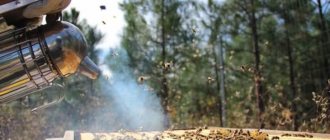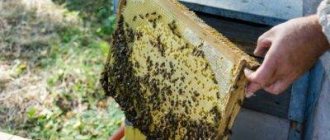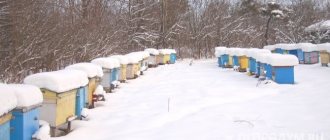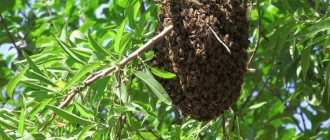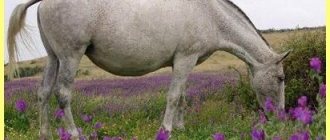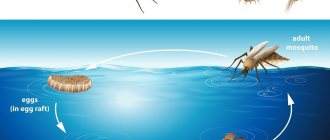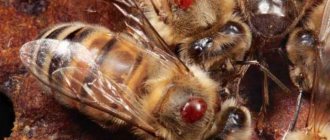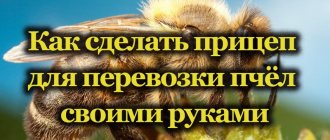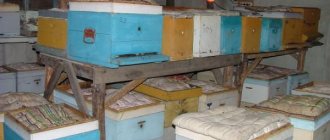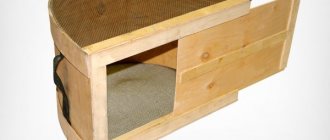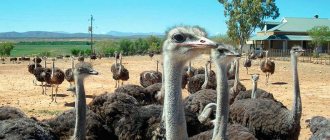The main task of the beekeeper in the cold season is to ensure that the bees overwinter with the least loss of bees and honey and meet spring healthy and vigorous. In winter, insects are inactive; any disturbance during this period is undesirable for them. Therefore, you need to prepare for the cold so that during cold weather you do not have to open the hives for inspection and feeding.
How much honey to store for the winter
No matter how good honey is, it is not 100% digestible. A little less than 2% of what is eaten goes into feces, which accumulate in the bees until the first flight - until spring. In total, a bee's intestines can hold 40 mg of undigested residues, which means they can eat 2 g of honey over the winter. For a strong family of 10,000 individuals, the amount of honey for the winter is 20 kg.
Note : sugar syrup produces 0.6% indigestible residue, which is three times less than honey! However, there are almost no nutrients in the syrup, so when overwintering on sugar syrup, the bees are more depleted, and if they are infected with varroosis, the whole family may not survive the winter.
At first, the bees eat little - 750 grams per month. By the end of winter, feces accumulate and irritate the bees; due to stress, they consume more honey (they eat stress with sweets, just like us) - 1-1.2 kg. When the brood appears, they have to eat twice as much - 2-2.5 kg per month. Depending on the duration of wintering, bees need to store 25 kg of food for the winter in Siberia, 18 - in the south + 1.7-1.9 kg of beebread (2-3 frames). Then there will be no famine and there will be strength to breed new offspring.
Which honey is better to winter on?
The best honey is light. Bees overwinter better on light honey. These include:
- fruity,
- clover,
- lime,
- meadow,
- fireweed,
- melilot.
The darker the honey, the more minerals it contains - the easier it crystallizes and becomes inedible. Honey from colza, mustard, rapeseed is of little use for wintering, and if the summer was dry, then honey from heather, cotton and sunflower.
Honey crystallizes fastest at 13-14°C in the hive (the minimum temperature in the hive for wintering). The degree of crystallization is also higher (by 45%!) when wintering on dark honeycombs (honey sours faster on them). However, in strong colonies where all the honeycombs are occupied by bees, the honey almost never spoils. Conclusion - for a successful winter, we leave the family exactly as many frames as they can fit tightly!
Be sure to replace honeydew honey. Flower nectar contains natural antibiotics and phytoncides that prevent harmful microorganisms from developing.
Why honeydew honey is useful for humans and why it is destructive for bees - I advise you to read.
There are none in honeydew (the sweet secretions of aphids and small worms), so honeydew honey destroys the bees’ immunity and metabolism:
- absorption of water and nutrients from aqueous solutions deteriorates;
- toxic and mineral substances disrupt the function of the rectal glands - the intestines become full faster, and diarrhea begins;
- mineral salts, especially potassium and sodium, damage the epithelium of the hindgut, disrupt the function of the enzyme catalase (the protective function of the intestine) - bees' immunity decreases, and they become increasingly ill with nosematosis.
How to distinguish honeydew honey from regular honey? Honeydew honey can taste too sweet, and for some it tastes bitter or tastes like malt. The color is dark, sometimes dark green or almost black. In terms of smell - not aromatic, sometimes no smell at all or with a specific smell, unlike anything - not honey. The structure resembles tar - viscous, viscous, does not melt on the tongue for a long time. If in the fall there are many unsealed cells within the frame, it is probably honeydew (it is printed later than nectar). Replace such frames with good ones or prepare feeding in advance if you understand that there is not enough honey for the bees to overwinter normally.
Features of feeding bees
The winter period is inactive for bees, but this does not mean that they do not require feeding. Usually, by the end of winter, the food reserves in the combs dry up, and the insects need help with nutrition. Honey is a natural food, but if it is not available, it can be replaced with a surrogate - sugar syrup.
It’s better to prepare a sweet kandi mixture, which is done like this:
- The honey is heated and liquefied, and a little powdered sugar is added to it.
- The composition is kneaded for a long time until it becomes homogeneous.
- Flatbreads are made from it and packed in plastic film, in which holes are cut.
- Kandy is placed on top of the frames and insulated.
This feeding does not provoke insects to fly out during the cold season and provides them with a sufficient amount of nutrients. You can add a few salt granules and pollen to the mass.
Assembling the nest: arranging honey frames
Bees are completely independent creatures. In the wild, they prepare for the winter and successfully winter themselves. Domestic animals differ from wild ones primarily in that there is someone to take care of domestic ones. Therefore, the beekeeper’s task is not to interfere with them, but even better to help them a little. We have already decided on the amount of food to store for the winter; it’s time to talk about assembling a nest for wintering. This event is held in the first half of September (in more northern regions), in the middle and southern regions - it can be 2-3 weeks later. There are three main ways to assemble a bee nest for the winter:
- Double-sided assembly (for strong families): along the edges there are full-fledged honey sealed frames, next to them are honey feather frames, in the center are the honey ones (2-2.5 kg). Total quantity: so that the bees are completely tightly placed on all frames. When it gets colder, the bees will gather in a club, 1-2 outer frames will be empty.
- Forming a nest using the “Angle” or “Half-beard” method (for medium-sized families with 7-8 streets): on the one hand - the most full honeycombs, on the other - smaller ones, but in the extreme - at least 2 kg of honey.
- Assembling a “Beard” nest (for weak families with 5-6 streets or nucs with spare queens): full-copper combs in the center, low-copper ones at the edges.
Before assembling the nest, you need to remove the housings and extensions. Reduce the internal volume of the hive as much as possible to make it easier for the bees to warm it. Remove frames that contain little honey and frames with old, unfinished combs. Leave only full-bodied ones - from 2 kg of honey.
If you don’t want to bother with assembling a nest for the winter, here is a useful video on how to do without it, but to be honest, it’s somehow calmer the old fashioned way.
Treatment for varroatosis and other diseases
If you are sure that there are no ticks in your apiary, you are most likely mistaken. Alas, in a short time the invasion affected almost all apiaries in the world. And in our time, beekeepers are forced to put up with the parasite and somehow organize work in conditions of infection...
Keeping bees in multi-hull hives, as well as in houses of other systems, requires two-time processing when preparing for wintering. The first time is after the main trick. The goal is to raise young bees going into winter as healthy as possible.
Important! Overwintering of insects sucked out by a mite while still at the pupal stage can be fatal for them.
Alas, at this time there is still brood, which may contain a tick. In sealed cells, medicinal drugs have little effect on him. So even a good mite scree is not enough: the part of it located on the brood will still remain alive. Therefore, we treat it a second time before entering winter, when all the parasites are on the bees. This helps high processing efficiency.
There are physical methods of treatment, the most common is treatment in a heat chamber. Biological - various fragrant herbs, cuttings of drone brood, etc. The use of chemicals in different ways is common:
- spraying with medicinal solutions;
- placing medications in small dispensers in the hive;
- burning of special substances and fumigation with smoke;
- introduction of drugs into the composition of the fed medicinal syrup.
There is another tick, and it is more widespread than many people think. We are talking about the Acarapis woody mite; other names for the invasion are Isle of Wight disease, tracheal mite, creeping mite. Alas, this mite is invisible, and for a number of reasons beekeepers do not know enough about it. Therefore, often all manifestations of acarapidosis are attributed to varroaosis, and only treated for it...
There are other diseases of bees, but now we will not dwell on each in detail. The only thing worth saying is that any disease must be cured before wintering! Winter is already a difficult time for bees, and treatment options at this time are limited.
Keeping bees in multi-hull hives is very promising. The design allows servicing large apiaries with low labor costs. At the same time, it is not difficult to create optimal conditions for bees at each stage of development, which is rewarded with a high yield of marketable honey. Preparation for wintering in this case requires taking into account the characteristics of the structure. This should not be perceived as an additional difficulty: preparing bees for winter when kept in multi-hull hives is no more difficult than in hives of other systems. You just need to take into account their features.
What is a bee club in winter?
To avoid freezing, insects huddle together in a ball. Active individuals move inside and generate heat, while motionless individuals outside form a “shell.” Their job is to keep the heat out of the club. As the temperature drops, the club contracts.
It happens that not all the bees have time to join - they come running from neighboring streets and partially die. Below 13o in the hive the bees begin to become torpid. In order not to die, the bees begin to mix, eat a lot (you have to get energy from somewhere!), and within 0.5-5 hours they restore the temperature to 25° (not higher - when the temperature rises beyond 30°, the queen is already in a hurry to lay eggs). Then they rest for a day until the temperature drops again to 13o. It is at this time that sharp frosts are dangerous - temperature fluctuations when frozen bees inside the hive have not yet regained their strength. The club usually winters in one place. He moves only if there is not enough food. If he was sitting in the center, he may split into two parts - one will go to the right, the other to the left. This is bad - it is more difficult for small groups to warm up. Another bad scenario is when the club crawls in the direction where there is less honey, eats everything and starves, without crawling to the other end of the hive with good supplies. Therefore, it is important to assemble the nest correctly - leaving exactly as much food for the club as it needs for the winter. No more, no less.
Peace is the key to a successful winter. When bees are worried, they increase the temperature in the hive and keep it high for several days. This is a waste of energy and food, which means there is a risk of premature filling of the intestines and diarrhea. It’s not just cold weather or poor food supplies that can bother bees:
- Mice chew on honeycombs and irritate them with a pungent odor. They eat the heads and breasts of bees, but not the bellies. The presence of a mouse is recognized by its smell, droppings in the dead and headless dead.
- Light excites and lures bees out of their hives when wintering above zero. They need darkness for wintering. How then to carry out periodic inspections? Shine with a red lantern - bees do not distinguish red from black and do not mistake it for light.
- The noise makes the bees very nervous. When visiting the winter hut, try not to make noise, stomp, or slam doors. Soundproof the winter hut as much as possible.
Autumn revision
An autumn check of the bee colony is necessary so that all worker bees are strong, hardy and healthy by spring.
Undoubtedly, active measures should be carried out throughout the entire honey collection, but inspection before winter is an integral part of correct and timely preparation for winter.
To be more precise, this is the very first stage. During the work, shortcomings are identified that may interfere with successful wintering.
The beekeeper must take into account the following nuances:
- To estimate the number of young worker bees, thanks to which the whole family will survive during cold weather, the number of brood is taken into account.
- The most important point is the age of the queen bee, since the ability to sow brood depends on this. Accordingly, the number of the whole family increases.
- Qualitative indicators of feed reserves - honey and bee bread. If their quality or quantity does not meet the requirements, the bee family will be weakened and many individuals will die.
- The condition of worker bees – their activity, performance, presence of diseases.
- Suitability of honeycombs for wintering.
To evaluate all the nuances, the beekeeper must carefully examine the hives and insects. The inspection is carried out under favorable weather conditions, since otherwise the habitual mode of life for bees is disrupted.
Winter hut for bees
What is a winter shelter? Already from the name it becomes clear that this is a wintering room. Typically insulated. This can be a specially equipped omshanik, or an ordinary cellar, basement, attic, veranda, etc.
Note: hives are brought into the winter hut after the last flight, when the bees have emptied their intestines for the winter. It is important that young bees from the new brood also participate in this - they have the most feces inside, and without flying around they may not survive the winter.
What temperature should be in the winter hut
The optimal temperature in the winter hut is within 0-2 degrees, up to +4 or -2-3. Bees tolerate cold more easily than heat, but a decrease in temperature in the winter hut by 4-5 degrees is bad. Water vapor settles on the walls and ceiling of the winter hut and turns into frost. When it warms up, it melts - it turns out damp, and this is mold, plus the honey liquefies and flows out of the honeycombs, floods the bees and turns sour. Trays with a 2-3 cm layer of lime help prevent excess moisture - it absorbs moisture well.
Excessive dryness is also bad. Printed honey absorbs moisture from the air - for bees in the winter hut this is the only source of water. If the air is dry, the bees will suffer from thirst. Due to dryness, honey becomes candied and becomes inedible. The best wintering is at 80-90% humidity. To combat dryness, you can hang wet rags around the winter hut or simply wet the floor.
Disease Prevention
The most common problem for beekeepers is mites. Currently, the mite infestation has spread throughout the planet, so it is important to learn how to fight the pest.
For the best effect, the hives are treated twice before winter. During this period, ticks are on the brood in dense cells, so the drugs do not affect them. In this regard, a second treatment is needed, when all the parasites are on the bees. It is important that by the beginning of winter there are no ticks at all; one pest will multiply and destroy the entire family.
Processing methods:
- physical (use of a thermal chamber);
- biological (natural herbs);
- chemical (special preparations and acids).
In addition to mites, bees are also affected by other diseases. The beekeeper must carry out infection prevention with medications or other methods. By the beginning of the winter period, each individual should be healthy.
Hive ventilation in winter
A bee colony exhales 5 liters of water in the form of steam during the winter. Once again - five liters of water per hive! How many hives do you have? Exactly…
Naturally, excess moisture must be released from the hive - provide ventilation in advance, leave the entrances slightly open, and if there are no upper ones, then bend the edges of the canvases by 1 cm. Ventilation in the hive is also needed for air exchange. Warm water vapor escapes through the top. Cold air comes from below. The greater the temperature difference between inside and outside, the faster the air circulates.
If it gets sharply cold, the air changes very quickly, and the bees do not have time to warm it up. You must manually cover the ventilation holes. If it’s too warm outside, then the ventilation is weak, and you need to increase it, otherwise dampness will form. Dampness is a source of mold and foulbrood.
Wintering bees outside
Wild swarms survive even forty-degree winters. Strong indoor families can duplicate this achievement by covering them with a half-meter layer of snow (or more). Snow protects from the wind, maintains an even temperature (even at -40 under the snow it is not lower than -4) and allows air to pass through, that is, “breathes”. To prevent the hive from coming into contact with the snow, but to create an air cushion, you need to cover the hive with insulation (needles, dry leaves, moss). Cover it on all sides - even from below (for example, place it on a box with leaves, shavings, pine needles): in hives with an insulated bottom, the temperature is 3-5 degrees higher.
When wintering outside, it is important to leave the ventilation open so that the damp air can escape! Open the entrances, but cover them with canopy boards so that snow does not get inside and so that the sun's rays never penetrate inside and lure the bees out before their time. After wintering in the wild, bees swarm less and are more productive, but in the process they spend 3-4 kg of food more than in winter huts, since they fly around earlier and raise their young earlier.
Prepare more food in advance and protect the hives from mice, since a wooden house outside is an easy target.
Possible problems
To preserve bees in winter, it is important to provide them with favorable conditions. At the same time, beekeepers often face the following problems:
- Feed shortage. In order for insects to survive the winter normally, they need to be fed properly. It is important to use food of proper quality. Light varieties of honey are most suitable for wintering - for example, linden. Dark varieties crystallize quickly, and therefore bees cannot eat such food.
- Violation of ventilation. Insufficient ventilation leads to nests becoming damp. Wet frames and mats cause the nest to cool down. This entails an increase in feed consumption.
- Development of diseases. Initially, a sick family should not go for the winter, as the situation will worsen. The most common disease is varroatosis. Infected bees are characterized by restless behavior, wear out, consume a lot of food and die.
- Weakness of families or lack of individuals. A weak bee colony will not be able to survive the winter. Only strong individuals are resistant to survival conditions. In addition, caring for young individuals is of great importance. It is important that in the fall there are at least 3 frames of brood in the hive.
Wintering of bees is considered a fairly important stage of their life. For it to be successful, it is important to provide the insects with suitable conditions and feed them correctly.
Wintering in shelters, trenches, under straw
Let's take a brief look at three other popular methods of wintering outside. In essence, this is still the same wintering in the wild (not in omshanik), but there are nuances:
- Wintering in casings - usually for groups of 4-6 hives. Build wooden frames around the hives, fill the space inside with leaves (moss, sawdust, shavings, pine needles). Cover the casings themselves with snow too.
- Wintering under straw bales. Place the hives on wooden platforms and cover all sides with 50 cm bales of straw. Leave both entrances open.
- Wintering in trenches - on the southern slope in dry, elevated places, so that it does not flood in the spring. The depth and width are one meter per meter, slightly narrower at the bottom, wider at the top. Length – according to the number of hives (no more than 25). Cover the floor with 3-5 cm of sand, logs or slabs on the bottom, and hives on top so that they do not touch the walls of the trench and each other. Open the lower entrance completely, bend the canvas at the back wall by 0.5-1 cm. For the hive - croaker and straw 30-50 cm, dry soil up to 50 cm. Make slopes so that water does not penetrate inside, and a drainage groove. In the center there is a 10x10 cm ventilation pipe, cover the top from snow and rain, close it only if it is colder than -20.
Another useful video about the reasons for poor wintering:
The main disadvantage of wintering in the wild is animals and envious neighbors. Mostly, most likely neighbors.
Video
We offer several videos with useful information on organizing the wintering of a bee colony in the wild and in the winter hut, proper ventilation to prevent condensation and other subtleties of beekeeping:
An avid gardener, beekeeper and gardener, partial to dogs and cats and other pets. Spends spring, summer and autumn at the dacha and experiments in the garden beds. Loves to communicate with “advanced” summer residents and find something new and useful for himself. Collects the best methods of preparation and recipes for preparing dishes from products grown with your own hands. He is happy to share his discoveries and secrets with readers.
Found a mistake? Select the text with the mouse and click:
In little Denmark, any piece of land is a very expensive pleasure. Therefore, local gardeners have adapted to growing fresh vegetables in buckets, large bags, and foam boxes filled with a special earthen mixture. Such agrotechnical methods make it possible to obtain a harvest even at home.
Compost is rotted organic remains of various origins. How to do it? They put everything in a heap, hole or large box: kitchen scraps, tops of garden crops, weeds cut before flowering, thin twigs. All this is layered with phosphate rock, sometimes straw, earth or peat. (Some summer residents add special composting accelerators.) Cover with film. During the process of overheating, the pile is periodically turned or pierced to bring in fresh air. Typically, compost “ripens” for 2 years, but with modern additives it can be ready in one summer season.
Natural toxins are found in many plants; Those grown in gardens and vegetable gardens are no exception. Thus, the seeds of apples, apricots, and peaches contain hydrocyanic acid, and the tops and peels of unripe nightshades (potatoes, eggplants, tomatoes) contain solanine. But do not be afraid: their number is too small.
Humus is rotted manure or bird droppings. It is prepared like this: the manure is piled up in a heap or pile, layered with sawdust, peat and garden soil. The pile is covered with film to stabilize temperature and humidity (this is necessary to increase the activity of microorganisms). The fertilizer “ripens” within 2-5 years, depending on external conditions and the composition of the feedstock. The output is a loose, homogeneous mass with a pleasant smell of fresh earth.
Tomatoes have no natural protection against late blight. If late blight attacks, any tomatoes (and potatoes too) die, no matter what is said in the description of the varieties (“variety resistant to late blight” is just a marketing ploy).
Convenient Android applications have been developed to help gardeners and gardeners. First of all, these are sowing (lunar, flower, etc.) calendars, thematic magazines, and collections of useful tips. With their help, you can choose a day favorable for planting each type of plant, determine the timing of their ripening and harvest on time.
In Australia, scientists have begun experiments in cloning several varieties of grapes grown in cold regions. Climate warming, which is predicted for the next 50 years, will lead to their disappearance. Australian varieties have excellent characteristics for winemaking and are not susceptible to diseases common in Europe and America.
You need to collect medicinal flowers and inflorescences at the very beginning of the flowering period, when the content of nutrients in them is highest. Flowers are supposed to be picked by hand, tearing off the rough stalks. Dry the collected flowers and herbs, scattered in a thin layer, in a cool room at natural temperature without access to direct sunlight.
One of the most convenient methods for preparing a harvest of vegetables, fruits and berries is freezing. Some believe that freezing causes the nutritional and health benefits of plant foods to be lost. As a result of the research, scientists have found that there is practically no decrease in nutritional value when frozen.
How often to check the hive
When wintering indoors, bees need to be checked once or twice a month and each time after sudden temperature changes. In the middle of wintering, you can visit with a red flashlight once a week, when the snow melts - 2 times a week. Before leaving the winter hut, it is worth visiting the bees every day so as not to miss the first warm day for the long-awaited flight. In winter, the condition of families can be determined by the hum (even - good, strong or weak - bad) and by death:
- grains of sugar - honey has crystallized;
- wet dead – high humidity, honey can become sour;
- mouse feces and headless bees - mouse (we put mousetraps and a net around the hive);
- swollen abdomen - diarrhea, nosematosis or other infection.
Scoop out all the dead meat, as much as there is, and burn it in the stove - it may contain viruses and infections.
